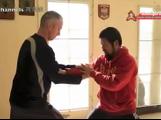1. Core Taiji movement. 2. Shoulder. 3. Central Equilibrium. 4. One-Third theory. 5. Movement without moving. 6. Knee. 7. Ankle.
Second video added 1.Tile Hand 2.Wrist 3. Head – Inside and Outside, Rotation and Catch. Presenter: Chen Zhonghua Length: 25 min + 17 min. In: English Year: 2012 Difficulty:4/5 At:Maple Ridge, B.C. Canada



{ 10 comments… read them below or add one }
Very important video to show how body parts function as a whole in Taiji.
As Calvin said, Very Important video! Many aspects that Master Chen has talked about before in many other videos, but the way they are consolidated and discussed together gives a much clearer picture of how structure is manipulated with very little movement to generate power. In addition, there are aspects that I’ve never seen previously talked about in such detail. Thank you!
I really appreciate the additional video. It helps considerably in understanding the ” 5 points struggling outward ” that is discussed in the “Body Structure” online video. It gives us a lot of clarity on the relationship between the suspended/isolated head and ” the finger coming out”, as well as producing a “bite”. When I’ve heard the term “bite” used before, the only thing I’ve had to relate it to is drilling… steel for example…(25 years in construction industry). When you try to drill steel; the bit must be harder than the steel your drilling, (steel varies considerably in hardness depending on the application), and sufficient pressure has to be maintained in one spot in order to “bite” into the material, otherwise the drill bit just spins and wanders around on the steel. So it’s really one part “tightness/taking out space” and one part focusing the power that’s applied to a single tiny dot at the very tip of the bit. Anyone who has done it will know if your mind is not focused onto it, the drill bit will just slide around never achieving a bite. I’m gradually gaining understanding as to why the rules are the way they are……so thank you for taking so much time to explain in such detail.
Drill bit has two cutting edges spiral up to cut through metal in spinning. However, I think ‘bite” is more like milling at the side rather than drilling at the bit.
Maybe thats the difference between “drilling force” and “shearing force”….the bit only rotates, the effect depends on where the opponent touches it?
Yes, I think so. Master Chen mentioned four typical forces in Taiji, force of outside a spinning wheel(shearing like milling bit), force inside a spinning wheel (like a blender), drilling force at the axis(like drill bit), explosive force (explosion of tire).
It would be nice if the preview gave a better sense of the content of the video, rather than focusing so much on music and special effects.
Master Chen is the one working on the videos. Cutting trailers properly is a time consuming process, so sometimes he uses iMovie trailer wizard to save time like in this case.
Master Chen is always consistent in his teaching and in his video presentation. As he is the one editing the final video, the result is up to his high standard.
I see– I didn’t know it was automated. There’s no question about the quality of the material, only the appropriateness for the individual learner. With the previews where you can hear some of the instruction, you can get a sense of “this is what I need to hear right now” or “I don’t understand any of this, I’ll come back later.” That’s really helpful in terms of managing time and budget.
Thanks for taking the time to reply. This site is a great resource and I know it takes a lot of work.
Shifu Chen often teaches in general principles. Understanding the principles establishes rules of movement that can be used throughout Taijiquan. These videos are different. Rather than principles, he shows physical methods for applying the principles that he teaches elsewhere. This is essential instruction.